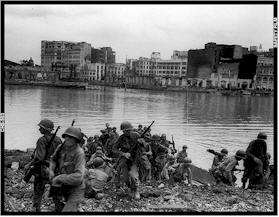In the fighting in the Harrison Park-Rizal Stadium-La Salle
University area, the 5th and 12th Cavalry Regiments lost approximately 40 men
killed and 315 wounded.9 The 2d
Naval Battalion, destroyed as an effective combat force, lost probably 750
men killed, the remnants fleeing northward to join units fighting against
elements of the 37th Division. The success at the park-stadium area paved the
way for further advances north along the bay front, and the 12th Cavalry had
begun preparations for just such advances while it was mopping up.
On 16 February, in the midst of the fighting in the stadium
area, the 1st Cavalry Brigade (less the 2d Squadron, 12th Cavalry) passed to the
control of the 37th Division. General Beightler directed the brigade to secure
all the ground still in Japanese hands from Harrison Park north to Isaac Peral
Street--fifteen blocks and 2,000 yards north of Harrison Boulevard--and between
the bay shore and Taft Avenue. The 5th Cavalry, under this program, was to
relieve the 148th Infantry, 37th Division, at another strongpoint, while the
12th Cavalry (less 2d Squadron) was to make the attack north along the bay
front. The 12th's first objective was the prewar office and residence of the
U.S. High Commissioner to the Philippines, lying on the bay at the western end
of Padre Faura Street, three blocks short of Isaac Peral.10
The 1st Squadron, 12th Cavalry, began its drive northward at
1100 on 19 February, opposed by considerable rifle, machine gun, and 20-mm.
machine cannon fire from the High Commissioner's residence and from private
clubs and apartment buildings north and northeast thereof. With close support of
medium tanks, the squadron's right flank reached Padre Faura Street by dusk,
leaving the residence and grounds in Japanese hands. During the day a Chinese
guerrilla informant--who claimed that his name was Charlie Chan--told the 12th
Cavalry to expect stiff opposition at the Army-Navy and Elks Clubs, lying
between Isaac Peral and the next street north, San Luis.11 The
units also expected opposition from apartments and hotels across Dewey Boulevard
east of the clubs. The two club buildings had originally been garrisoned by
Admiral Iwabuchi's Headquarters
Sector Unit, and the Manila
Naval Defense Force commander had
apparently used the Army-Navy Club as his command post for some time. Apartments
and hotels along the east side of Dewey Boulevard were probably defended by
elements of Headquarters Battalion and
some of the provisional attached units.
Behind close artillery support, the cavalry squadron attacked
early on 20 February and by 0815 had overrun the last resistance in the High
Commissioner's residence and on the surrounding grounds. The impetus of the
attack carried the squadron on through the Army- Navy and Elks Clubs and up to
San Luis Street and also through most of the apartments, hotels, and private
homes lying on the east side of Dewey Boulevard from Padre Faura north to San
Luis. Only 30 Japanese were killed in this once-important Manila
Naval Defense Force command post
area; the rest had fled into Intramuros or been used as reinforcements
elsewhere. The 1st Squadron, 12th Cavalry, lost 3 men killed and 19 wounded
during the day, almost the exact ratio of casualties being incurred by other
U.S. units fighting throughout Manila.
Now facing the cavalrymen across San Luis Street were the
wide, open park areas of New Luneta, Burnham Green, Old Luneta, and the western
portion of Wallace Field, reading from the bay inland. About 500 yards north
across Burnham Green loomed the five-story concrete bulk of the Manila Hotel,
and north of Old Luneta and Wallace Field lay Intramuros. The South Port Area
lay just northwest of the Manila Hotel, the next objective. In preparation for
the attack on the hotel, the 82d Field Artillery Battalion intermittently
shelled the building and surrounding grounds throughout the night. A patrol of
Troop B dug in along the north edge of Burnham Green to prevent Japanese in the
hotel from breaking out to reoccupy abandoned bunkers in the open park area.
With artillery support and the aid of two 105-mm.
self-propelled mounts and a platoon of medium tanks, the 1st Squadron dashed
into the hotel on the morning of 21 February. As was the case in other large
buildings throughout the city, the hotel contained a series of interior
strongpoints, the basement and underground passages being especially strongly
held. Nevertheless, the hotel's eastern, or old, wing was secured practically
intact by midafternoon. Some Japanese still defended the basement and the new
(west) wing, but the cavalrymen cleaned them out the next day. The new wing,
including a penthouse where General MacArthur had made his prewar home, was
gutted during the fight, and the general's penthouse was demolished.12


